Use the Steep and shallow finishing page to create a Constant Z toolpath in the steep regions of a model and a 3D offset or Raster toolpath in the shallow regions.
This differs from Optimised constant Z finishing as you can specify when to change from 3D offset machining to constant Z machining using the Threshold angle field, and you can specify an Overlap where both steep and shallow toolpaths are created. Also, optimised constant Z finishing only uses whole segments, whereas steep and shallow finishing will split segments at the shallow boundary. This means that steep and shallow finishing toolpaths have far more retracts than optimised constant Z toolpaths.
Threshold angle — Enter the surface slope, measured from the horizontal, that determines the split between constant Z (steep) and shallow machining.
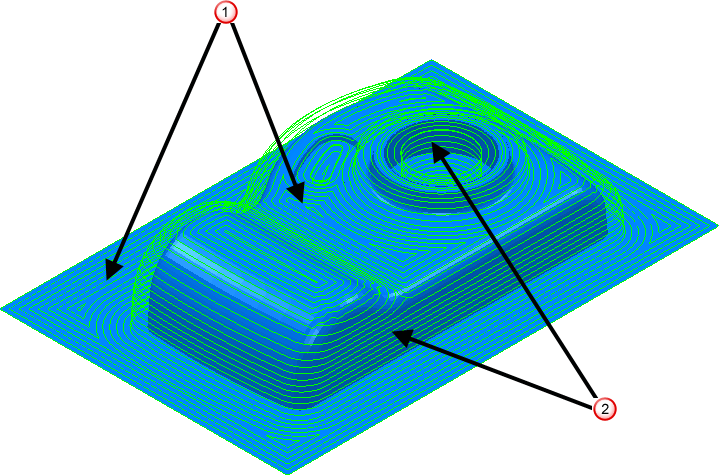
 — Shows the
3D Offset
toolpath in the shallow areas.
— Shows the
3D Offset
toolpath in the shallow areas.
 — Shows the
Constant Z
toolpath in the steep areas.
— Shows the
Constant Z
toolpath in the steep areas.
Steep shallow overlap — Enter the size of the overlap area where constant Z (steep) and shallow machining occur. This minimises marks on the model caused by a sudden switch from constant Z to shallow machining.
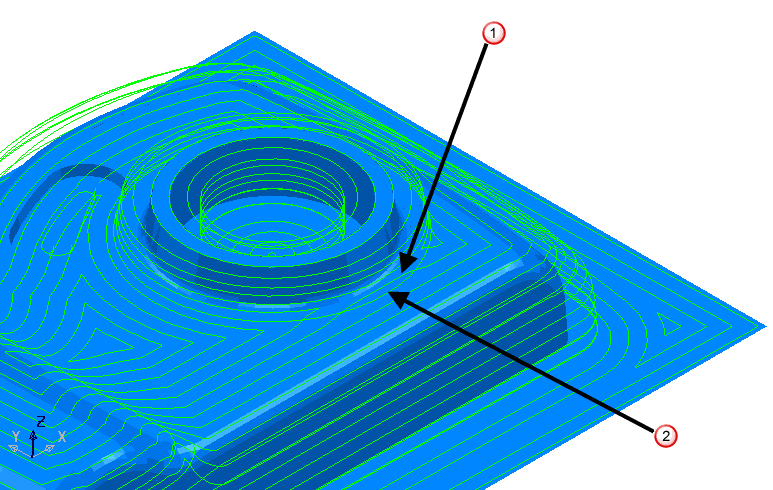
 — Shows the
3D Offset toolpath overlapping into the steep areas.
— Shows the
3D Offset toolpath overlapping into the steep areas.
 — Shows the
Constant Z toolpath.
— Shows the
Constant Z toolpath.
Steep — The options for the constant Z portion of the toolpath.
Shallow — The options for the raster/offset portion of the toolpath.
Spiral — Select this option to create a spiral path between two consecutive closed contours. This minimises the number of lifts of the tool and maximises cutting time while maintaining more constant load conditions and deflections on the tool.
Selecting Spiral converts this:
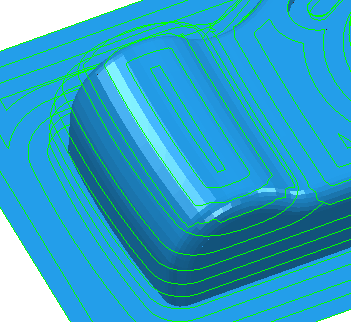
to this:
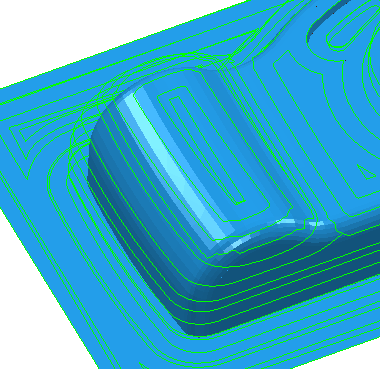
Cut direction — Select the milling technology.
Select a Cut Direction from the following:
-
Climb — Select to create toolpaths using only climb milling, where possible. The tool is on the left of the machined edge when viewed in the direction of tool travel.

-
Conventional — Select to create toolpaths using only conventional or upcut milling, where possible. The tool is on the right of the machined edge when viewed in the direction of tool travel.

- Any — Select to create toolpaths using both conventional and climb milling. This minimises the tool lifts and tool travel.
Stepdown — Enter the distance between successive machining passes. The Stepdown is for the steep portions of the toolpath.
Stepover — Enter the distance between successive machining passes. The Stepover is for the shallow portions of the toolpath.
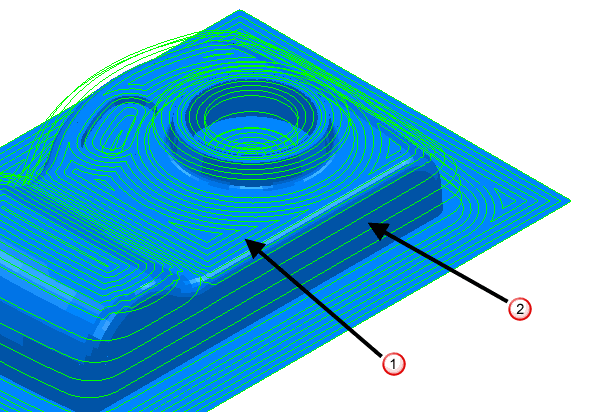
 — Shows the
3D Offset toolpath stepover in the shallow areas.
— Shows the
3D Offset toolpath stepover in the shallow areas.
 — Shows the
Constant Z toolpath stepdown in the steep areas.
— Shows the
Constant Z toolpath stepdown in the steep areas.
 Copy stepover from tool — Click to load the radial depth of cut from the active
tool's cutting data. The radial depth of cut is measured normal to the tool axis.
Copy stepover from tool — Click to load the radial depth of cut from the active
tool's cutting data. The radial depth of cut is measured normal to the tool axis.
 Edited — When displayed, shows value entered by you (or another user). Click
Edited — When displayed, shows value entered by you (or another user). Click
 to change this value to the automatically calculated value.
to change this value to the automatically calculated value.
 changes to
changes to
 .
.
 Cusp height — Enter the maximum cusp height and use this value to determine the stepover.
PowerMill calculates the stepover value to give a cusp height of the machining tolerance using the current tool, when machining a plane inclined at 45
Cusp height — Enter the maximum cusp height and use this value to determine the stepover.
PowerMill calculates the stepover value to give a cusp height of the machining tolerance using the current tool, when machining a plane inclined at 45 . This is the worst case cusp height for any given tolerance.
. This is the worst case cusp height for any given tolerance.

 Stepdown
Stepdown
 Stepover
Stepover
 Cusp height
Cusp height
For more information see Linkage between stepover and cusp height.
Calculate using cusp — Select this option to determine the stepdown by the Cusp height, with a maximum stepdown determined by the Maximum stepdown value. When deselected, the stepdown between successive Z heights has a constant value equal to the Minimum Stepdown value.
Type — Select whether PowerMill creates a Raster or Offset toolpath in the shallow regions.
Type — Offset

Type — Raster

Smoothing —Select this option to smooth offsets of toolpath segments over the model.
Selecting the Smoothing option converts this:

to this:
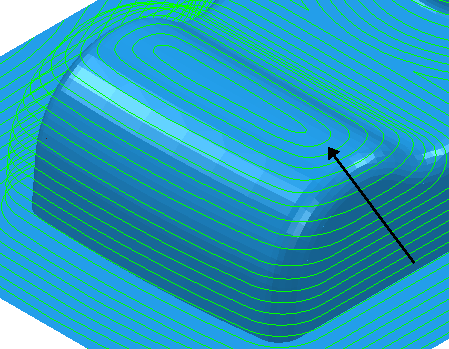
Centreline — Select to include a pass over the centreline of toolpath corner junctions. This removes small cusps created at the junctions.
Centreline off:
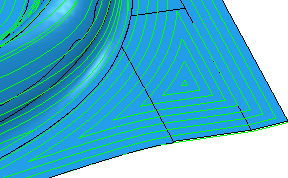
Centreline on:

Tolerance — Enter a value to determine how accurately the toolpath follows the contours of the model.
Thickness — Enter the amount of material to be left on the part. Click the
Thickness
 button to separate the
Thickness
box in to
Radial thickness
button to separate the
Thickness
box in to
Radial thickness
 Axial thickness
Axial thickness
 . Use these to specify separate
Radial and
Axial thickness as independent values. Separate
Radial and
Axial thickness values are useful for orthogonal parts. You can use independent thickness on sloping walled parts, although it is more difficult to predict the results.
. Use these to specify separate
Radial and
Axial thickness as independent values. Separate
Radial and
Axial thickness values are useful for orthogonal parts. You can use independent thickness on sloping walled parts, although it is more difficult to predict the results.
 Radial thickness — Enter the radial offset to the tool. When 2.5-axis or 3-axis machining, a positive value leaves material on vertical walls.
Radial thickness — Enter the radial offset to the tool. When 2.5-axis or 3-axis machining, a positive value leaves material on vertical walls.

 Axial thickness — Enter the offset to the tool, in the tool axis direction only. When 2.5-axis or 3-axis machining, a positive value leaves material on horizontal faces.
Axial thickness — Enter the offset to the tool, in the tool axis direction only. When 2.5-axis or 3-axis machining, a positive value leaves material on horizontal faces.

 Component thickness — Click to display the
Component thickness
dialog, which enables you to specify the thicknesses of the different surfaces.
Component thickness — Click to display the
Component thickness
dialog, which enables you to specify the thicknesses of the different surfaces.